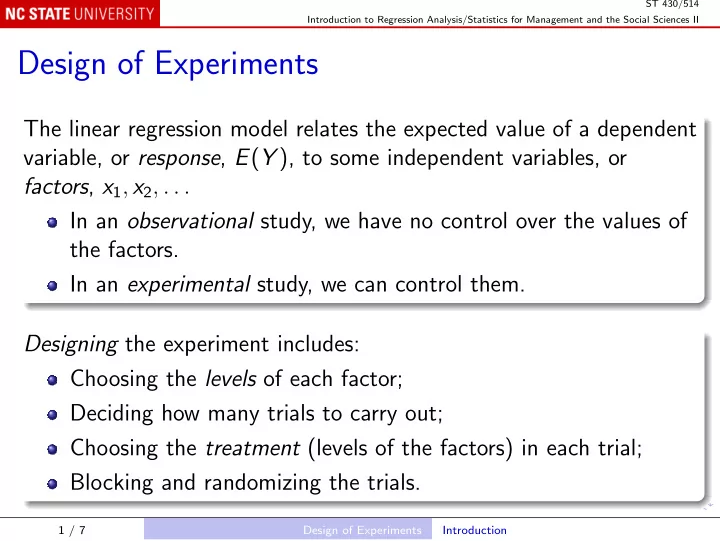

ST 430/514 Introduction to Regression Analysis/Statistics for Management and the Social Sciences II Design of Experiments The linear regression model relates the expected value of a dependent variable, or response , E ( Y ), to some independent variables, or factors , x 1 , x 2 , . . . In an observational study, we have no control over the values of the factors. In an experimental study, we can control them. Designing the experiment includes: Choosing the levels of each factor; Deciding how many trials to carry out; Choosing the treatment (levels of the factors) in each trial; Blocking and randomizing the trials. 1 / 7 Design of Experiments Introduction
ST 430/514 Introduction to Regression Analysis/Statistics for Management and the Social Sciences II Forensics Example Developing an instrument for identifying the dye on a fiber: http://www.aspe.net/publications/Short%20Abstracts% 2012A/3611.pdf Mass Spectrometry Example Improving the operation of a mass spectrometer: https://www.ncbi.nlm.nih.gov/pmc/articles/PMC3145359/ 2 / 7 Design of Experiments Introduction
ST 430/514 Introduction to Regression Analysis/Statistics for Management and the Social Sciences II Example 11.1 A marketing study on weekly coffee sales: Select the factors: brand and shelf location; 1 Choose levels of each factor: 2 Two brands (A and B); Three shelf locations (bottom, middle, and top); Choose the treatments: 3 Complete factorial design uses all 6 combinations of factor levels; Decide sample size for each treatment (3, in the example); 4 Assign treatments to experimental units (weeks 1 to 18). 5 3 / 7 Design of Experiments Introduction
ST 430/514 Introduction to Regression Analysis/Statistics for Management and the Social Sciences II Completely Random Design (CRD) To avoid the possibility that small time trends might be confused with factor effects, randomize the order of the treatments: design <- expand.grid(Rep = 1:3, Brand = c("A", "B"), Shelf = c("bottom", "middle", "top")) design[sample(1:18), -1] 4 / 7 Design of Experiments Introduction
ST 430/514 Introduction to Regression Analysis/Statistics for Management and the Social Sciences II Blocking Suppose that weeks 1–6 were at one store, weeks 7–12 at another, and weeks 13–18 at a third. Complete randomization might put brand A more often at store 1, which might have higher overall coffee sales. Randomized Complete Block Design (RCBD) Assign all 6 treatments once to each block (store), and randomize the order within blocks: design <- expand.grid(Brand = c("A", "B"), Shelf = c("bottom", "middle", "top"), Block = 1:3) design[c(sample(1:6), sample(7:12), sample(13:18)),] 5 / 7 Design of Experiments Introduction
ST 430/514 Introduction to Regression Analysis/Statistics for Management and the Social Sciences II Fractional Factorial Designs Sometimes many candidate factors need to be evaluated. If k factors have been identified, and each is used at only 2 levels, there are 2 k treatments. If we do not have the resources to carry out even a single replicate of the complete 2 k design, we use a carefully chosen fraction of the treatments. 6 / 7 Design of Experiments Introduction
ST 430/514 Introduction to Regression Analysis/Statistics for Management and the Social Sciences II One quarter fraction of the 2 5 factorial (2 5 − 2 ) design <- expand.grid(A = c(-1, 1), B = c(-1, 1), C = c(-1, 1)) design$D <- design$A * design$B design$E <- design$A * design$C design$y <- rnorm(8) summary(aov(y ~ A * B * C * D * E, design)) summary(aov(y ~ A + B + C + D + E, design)) summary(lm(y ~ A * B * C * D * E, design)) 7 / 7 Design of Experiments Introduction
Recommend
More recommend